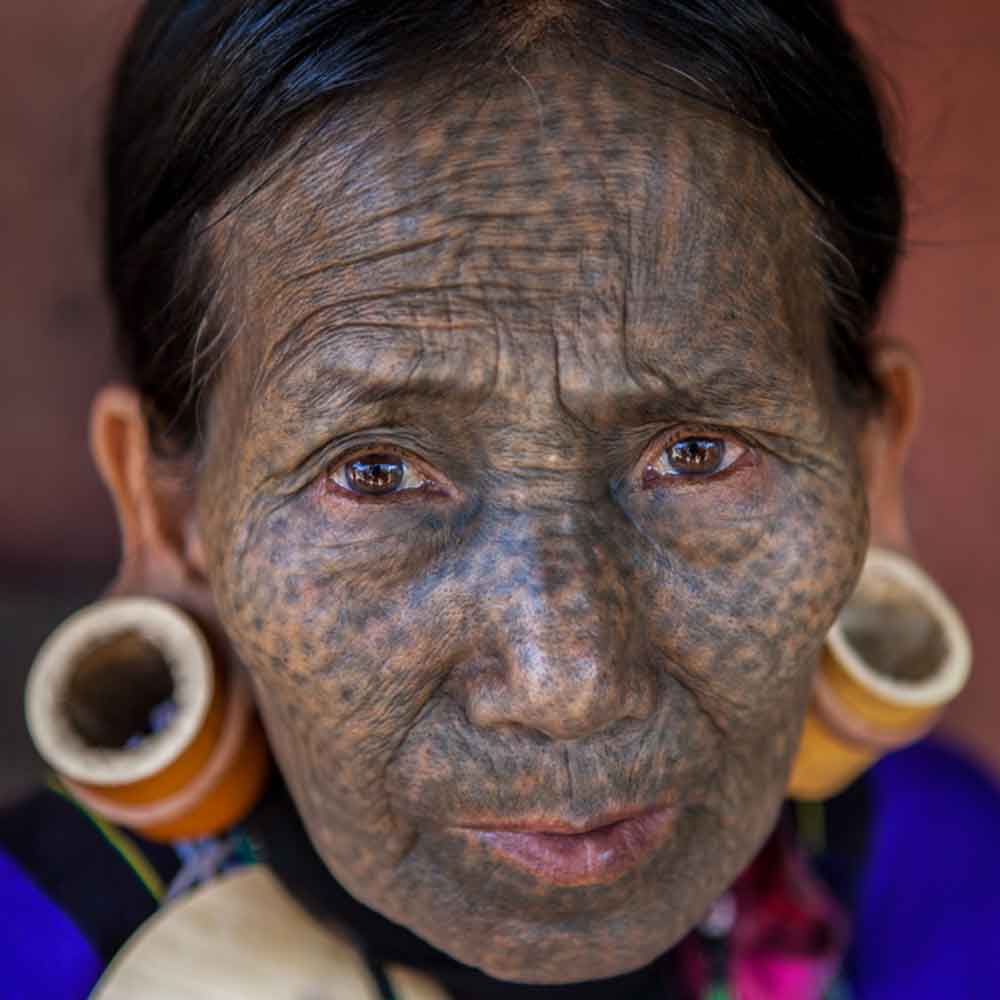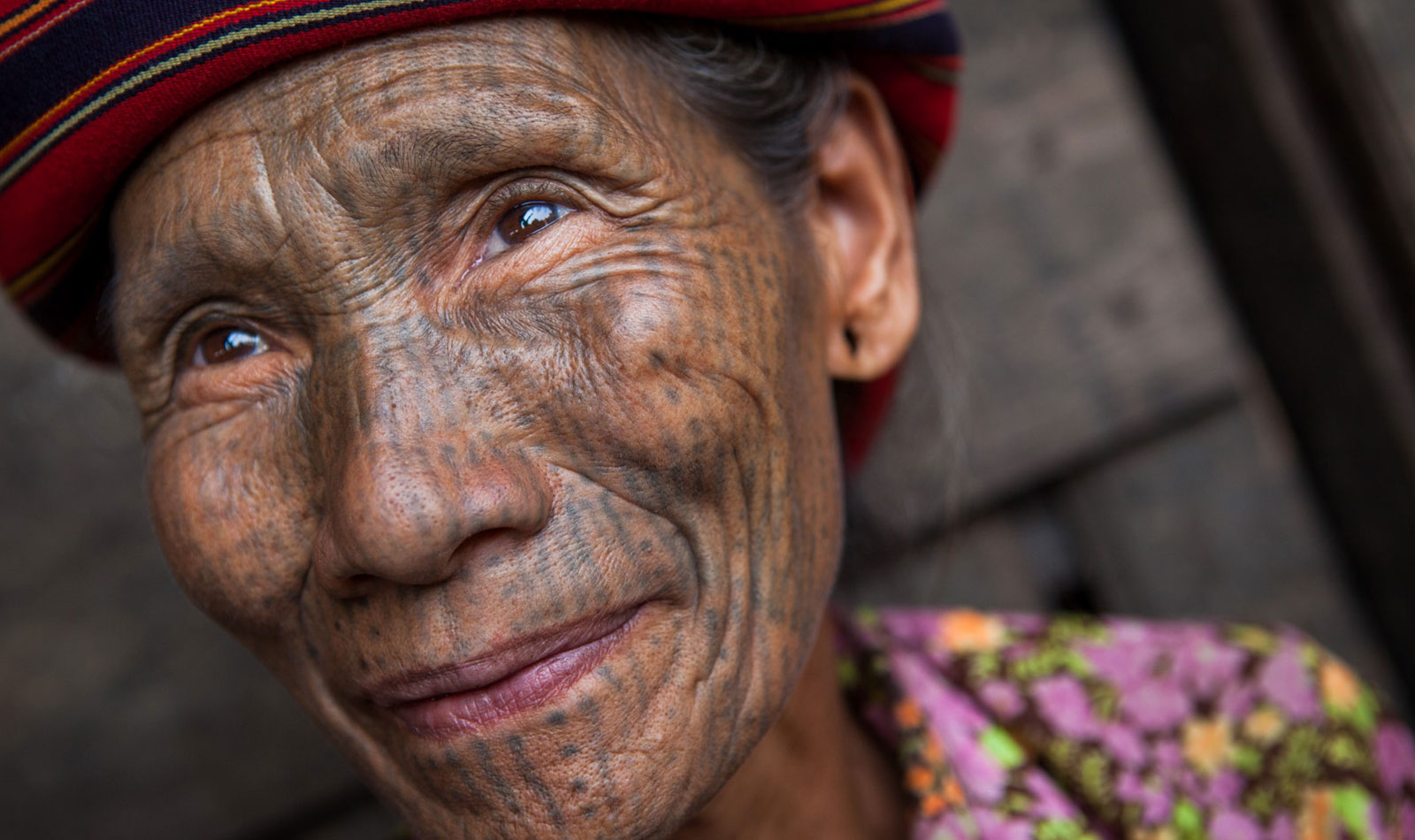Tattooed Faces & Fading Traditions: The Women of Chin State, Myanmar
This article was published in National Geographic Traveller, 2016, Issue 1, PDF
PHOTOGRAPHY BY PHILIP CHARLIE MALMQVIST
For more than a millennium, Myanmar’s Chin community tattooed the faces of their young women. But during the 1960s, the government banned the practice, and now only a handful of these tattooed women remain.
THE LAST RAYS OF DUSK shoot across the Arakan Mountains in Chin State, Myanmar, piercing gaps in the wooden wall and casting the rustic room in a warm orange glow as I sit cross-legged on the cold, hard floor. A wood fire crackles to my left, spitting sparks and billowing smoke, and in the distance—and just outside—I can hear roosters crowing.
But it’s the tattooed face of the elderly Muun tribeswoman preparing my drink in the shadows of the stilt house that has my full attention. Her wrinkled face is a canvas of lines and geometric shapes that were etched onto her skin with a sturdy pine needle daubed with army-green ink when she was just 12 years old. And as she approaches and places a jug of khaung yay—a traditional alcoholic drink made from fermented millet seeds, also known as ‘juice’—on the teak table before me, what appears to be a film of tears makes her eyes twinkle in the light of the setting sun.
“The ink was made from buffalo kidney, soot and local plants,” says Aung Nay Kay as he hands me a glass of the local brew. A soft-spoken Burmese man with kind eyes and grey hairs sprinkled throughout his dark locks, Aung rents out bikes and sells gemstones and bus tickets with his wife in Bagan, home to the vast archaeological site that is Myanmar’s main tourist attraction. However, he also acts as a guide for foreign travellers on the side.
After downing my first glass of the cloudy sweet-and-sour concoction, I’m gently encouraged to drink more. It doesn’t take long for a warm, fuzzy feeling to creep over me, but I’ll be meeting more of the tattooed women in the morning, so after I’ve downed my fifth glass, I bid my hosts goodnight, climb into bed and drop like a stone into a deep sleep.
Fading tradition
FACIAL TATTOOING among Muun and other Chin State tribeswomen goes back at least 1,000 years, but it’s a tradition that’s fading into the recesses of history, propelled by a 55-year government ban and the realities of modernity. Only a handful of the ‘illustrated women’ remain, and they’re all now in their later years. I’m here in Mindat—a 200-kilometre, seven-hour overland journey from dusty Bagan through Myanmar’s arid central plains—to meet them and learn about this ancient custom before it disappears like trails in some forgotten jungle. After all, it isn’t often you come face-to-face with a dying cultural tradition.
I wake the next day to the sound of creaking floorboards and muffled speech, which culminates in a knock on my door. It’s Aung, and it’s time to leave Victoria Guesthouse to meet the tattooed elders. Opening the shutters on my window I’m greeted with a scene from a Chinese watercolour—rolling mountains hide behind clouds of morning mist under an arcing sky streaked with swathes of pink and purple. I sit and drink in the vista for a while before heading downstairs for a breakfast spread of white rice, curried meats, spiced vegetables and hot tea.
“Over time, the facial tattoo became the hallmark of Chin womanhood—a part of Chin identity.”
Mindat is already awake by the time I slip on my tattered shoes and head outside. Children walk hand-in-hand in pairs towards the local school while men sit and sip and smoke in roadside tea houses along the town’s main drag—a dusty stretch of potholed bitumen that’s lined with weather-beaten wooden buildings in dire need of a paintjob. It feels as though I’ve been transplanted to a town in an old Western; at any minute I expect to see a tumbleweed blowing across the road. Meanwhile, women dressed in colourful longyis (sarongs) set up their roadside shops, peddling red-hot chillies, bananas and, of course, thanakha—the pale, yellowish paste made from ground bark that many Burmese smear on their faces to protect them from the sun.
Indelible identity
“HE ISN’T ANSWERING HIS PHONE,” Aung nervously tells me, referring to Ling ‘Cookie’ Naing, who will be our translator and guide among the tribes today. The Chin language—of which there are more than 20 dialects—is completely different to Burmese, and is itself at risk of dying out. Cookie arrives ten minutes later on the back of a black Chinese-made motorbike. After sheepishly apologising for his tardiness, he directs us to a maroon Toyota Hilux to begin our drive out to the tribal settlements, which are located just outside Mindat proper.
As we drive, Cookie provides some history about the practice of facial tattooing among the Chin. According to local lore, girls in this part of Burma were so beautiful that they were often kidnapped by the kings of neighbouring areas and forced into marriage. In an effort to stop the kidnappings, the Chin elders decided to tattoo the faces of their young girls in order to neutralise their inherent beauty. Their plan worked and the kidnappings stopped.
However, over time, the facial tattoo became a hallmark of Chin womanhood—a part of Chin identity—and, ultimately, a symbol of beauty. “Men wouldn’t marry a woman without the tattoo. They were not considered beautiful,” Cookie tells me over his shoulder as we begin to descend into a valley. “But the government doesn’t want these tattoos, and most of the young girls don’t want them either. They want to fit in at school; they want to be normal.”
We slow down and pull over to the side of the road to begin our short hike down to our first Chin settlement, which is located on the valley slope. The dirt path is steep and rocky, and I grasp onto tree trunks for extra support as I gingerly take things one step at a time. Cookie, meanwhile, descends gracefully and unaided, occasionally stopping to point out various medicinal plants.
Eventually, we reach a dusty clearing where a couple of weathered bamboo huts on stilts stand in the shade of the forest canopy. Outside one of the huts, sitting on a tree stump, is an old woman dressed in a white top and purple longyi. Her face is covered from ear to ear with dark ink, like a mask.
There are several different Chin subgroups in Myanmar, each with their own distinctive tattoo ‘signature’, making it possible to tell where a Chin woman comes from based on the tattoo on her face. This woman’s tattoo marks her out as a member of the Uppriu.
She appears calm and composed, but as she turns to me and speaks I see melancholy in her eyes. “The tattoo took more than two days to complete,” Cookie translates for me. “She remembers crying a lot during the ordeal and being sore for weeks afterwards. She was 16 years old.”
Payment for the tattoos was made in livestock, cash and a pot of juice. “The skin around her eyes was especially painful, but they drank juice to make it less so,” Cookie continues. In some cases, the tattoos became infected and girls would die after getting inked, he tells me. The effect of the tattoo is striking, and I struggle not to stare.
Hunting, party
FURTHER DOWN THE VALLEY, we reach another settlement of traditional dwellings—this time belonging to members of the Muun subgroup. Boisterous chickens dart around and under the three stilt houses while a few children peek curiously from inside. We’re introduced to the settlement’s chief hunter, Kee Naing, who is busily sharpening his machete with the focus of a pro. Although he doesn’t have a facial tattoo, his wife does.
After shaking his leathery hand and exchanging smiles, we’re all invited to sit down on the bamboo verandah for some tea. Above us hang the skulls of about 20 gaur (Indian bison), covered in flesh and skin in various states of decomposition. The Chin are supremely skilled hunters, and a collection of animal skulls can be found hanging outside most Chin homes—a testament to the family’s hunting prowess.
On the bone-jarring drive back to our guesthouse, we slow down along a bend as a crowd of merry villagers spills out onto the road. It turns out that there’s a feast on today—and we’re invited. The smiling crowd treats us to meat from a freshly killed gaur, sticky white rice and, inevitably, more juice. As a glass is handed to me, I notice a few more tattooed tribeswomen in the gathering. They belong to the Daai tribe and their faces are covered in dark-green dots that resemble the spots of a leopard. By my third glass of juice I’m engaging in spirited if basic conversation with the revellers; by my fifth I’m gorging on more gaur; by my seventh I’m agreeing with my guides that it’s time to go.
My final evening is spent sipping tea in a traditional tea house with Aung. The day is winding down in town and I’m treated to another gorgeous sunset as Aung details the journey back to Bagan the next day. The two teenage Chin girls who served me tea just moments earlier are standing in the corner of the room, giggling each time our eyes meet. They represent the coming of a new Chin generation—still beautiful, but now with just thanakha on their faces.













